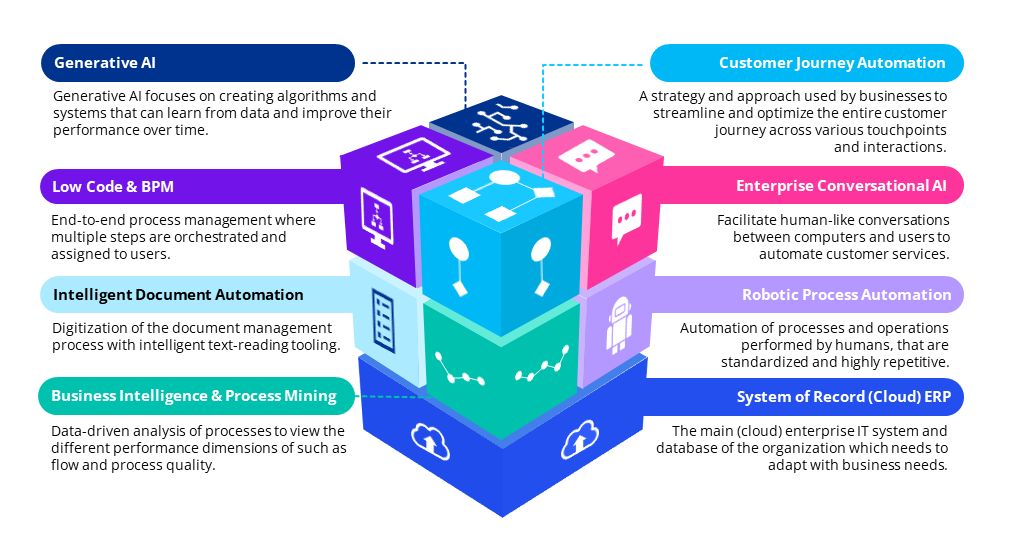The development of Artificial Intelligence (AI) systems is progressing at a lightning-fast pace. The latest news about generative AI (Gen AI) is being received with a mix of amazement and concern, and the complete implications, both in the short and the long run, remain uncertain. Gen AI is a subset of the umbrella term AI and can generate novel content, rather than simply analyzing or acting on existing data. Gen AI uses complex machine learning models to create content based on the input it receives from the user and its understanding of the data it can access.
Gen AI opens up a new realm of possibilities, one of which is helping organizations to overcome challenges they face while digitizing and optimizing processes end-to-end (E2E). It is possible to meet this challenge with known methodologies such as RPA, low-code and intelligent automation technologies, but combining these technologies with Gen AI significantly expedites the entire procedure.
This article delves into the what and the how of developing potential Gen AI use cases and implementing it in your organization’s operational processes. On the one hand, we focus on the positive side of Gen AI and how it will improve businesses. On the other hand, we elaborate on the challenges of implementing Gen AI in your organization, including the governance and ethical challenges. Towards the end, the article explains how Gen AI can enhance a company's digitization journey by combining Gen AI with the existing stack of digital technologies.
How does Gen AI improve operational processes inside your organization?
Gen AI provides many opportunities and can boost the efficiency and scalability of an organization’s processes, allowing employees to focus on higher-value tasks. Gen AI can be used for generating content tailored to a specific audience and accelerating manual or repetitive tasks.
One example is our Gen AI Pension Chatbot, which assists Corporate Sustainability Reporting Directive (CSRD) gap analyses. CSRD is a European guideline for sustainability reports and many companies are obliged to meet CSRD reporting standards. KPMG Sustainability Reporting performs a ‘gap analysis’ service, based on recently published annual and sustainability reports. Performing a gap analysis used to be a time-consuming process, but through prompt engineering, a chatbot is able to search sources, summarize and identify contradictions with reporting standards. This Gen AI-assisted technology accelerates the gap analysis process, reducing the need for resources. This technology is applicable to every comparable operational process inside organizations to reduce manual labor, such as inventory management, quality assurance for products and services, or reporting of organization’s operational data.
By leveraging Gen AI’s technology, organizations can create a data-driven decision-making process, resulting in a more strategic and successful business outcome. Yet there are many factors to consider when implementing Gen AI. We address these implementation factors in the following section on challenges.
Overcoming barriers while tackling challenges in implementing Gen AI
Implementing Gen AI into an organization's structures and processes can bring benefits if executed correctly. The implementation of Gen AI needs to meet certain preliminary conditions and be prepared to mitigate inherent risks. The major challenges to overcome for successfully implementing Gen AI in your organization are mostly related to workforce skills, data privacy, developing business cases and a clear strategy, and leadership.
A fundamental condition for Gen AI implementation is the possession of a skilled workforce capable of developing and integrating AI technologies, such as data scientists and software developers. There is a global talent shortage in these skill areas, which makes it difficult and costly for organizations to attract and retain talent. Another important investment lies in implementing data protection measures. Large enterprises often deal with vast amounts of sensitive data and are hesitant to fully embrace AI due to concerns about data breaches and privacy violations. By mitigating risks, they can create a solid foundation for Gen AI adoption. Additionally, it is important to explore and develop a clear business use case. This includes gaining a solid understanding of how Gen AI will address specific business needs, enhance operational areas or provide a new strategic direction. For a successful Gen AI implementation, it is also crucial that there is support from top leadership, including encouragement for a proper allocation of resources.
Ethical considerations are also at play, as the misuse of generated content might lead to a breach of intellectual property rights or privacy. Dealing with these challenges requires risk management, strong digital governance and the incorporation of robust ethical frameworks. Proactive governance of Gen AI is crucial to manage associated risks. This involves having a clear policy and framework to regulate how AI capabilities are developed and used within an organization. Without well-defined governance, there is a risk of AI systems operating in disregard of regulatory standards. It also could result in a lack of accountability for decision-making. Moreover, as Gen AI learns and adapts independently, there's the risk of ‘black box’ decision-making, in which case it's unclear how the AI came to a particular conclusion.

Figure 1: digital stack technologies can benefit from Gen AI in multiple ways
Elevating our digital stack with Gen AI
To fill the flaws of hyperautomation solutions, Gen AI can draw from a wide range of human experiences, knowledge, and common sense. Executives foresee that out of all emerging technologies Gen AI will have the largest impact on their businesses. The majority believes it will transform how organizations operate, communicate with customers, and generate revenue.
Gen AI holds the potential to substantially enhance hyperautomation efforts by giving computers unprecedented levels of creativity and adaptability, allowing organizations to achieve operational agility. In different forms, one of them being intelligent assistance, Gen AI acts as the backbone for interactions between users and the digital stack. This enhancement enables users to overcome issues related to complex interfaces, organizational implementation challenges, and integration obstacles. For example, Gen AI can provide additional information inside user interfaces, generate custom change management strategies, and automate E2E solution integration. This enables employees to execute their tasks more efficiently and effectively, resulting in improved business outcomes. Hence, hyperautomation solutions become more accessible and part of a bigger system.
Are you ready to join the Gen AI journey?
In summary, Gen AI can boost the efficiency and scalability of organization’s operational processes if executed correctly. Ethical, governance and implementation challenges should be tackled to implement Gen AI successfully. Gen AI holds the potential to substantially enhance hyperautomation by accelerating our digital stack, allowing organizations to achieve operational agility.
At KPMG, we guide clients on a tailored, structured journey from assessment and ideation to proof of concept in the emerging realm of Gen AI. Our approach consistently focuses on your business objectives, organization structure, employees, and customers. Leveraging our extensive knowledge and experience, and our well-established partnership with industry leader Microsoft, we empower clients to uncover the full potential of Gen AI. Our efforts are geared towards streamlining and modernizing data systems and tackling challenges, such as disparate data and inefficient workflows. We view automation not as a mere trend, but as a transformative opportunity to reshape the future of your business. The KPMG Hyperautomation Maturity Scan is a valuable tool to gauge your organization’s readiness for this transformation. The scan assesses your current state and provides an initial understanding of where your organization stands on the hyperautomation maturity scale. This deep insight will guide the subsequent steps in your automation efforts, aiding in maximizing value and enhancing return on your investments. Guided by our robust ethical and governance framework, we stand committed to a responsible and effective usage of Gen AI across your organization.



